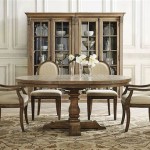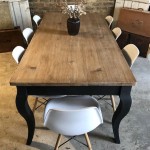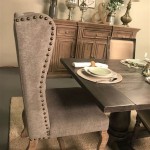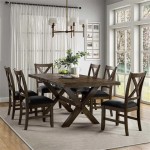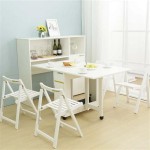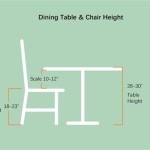Antique Dining Table With Leaves That Pull Out: A Timeless and Adaptable Centerpiece
Antique dining tables with leaves that pull out represent a significant investment in both functionality and historical artistry. These tables, often crafted from hardwoods such as mahogany, oak, walnut, or cherry, exhibit a level of craftsmanship rarely seen in modern furniture. Their pull-out leaves offer a flexibility unmatched by fixed-size tables, allowing for adaptation to various dining needs, from intimate family meals to larger gatherings. The inherent beauty of the wood grain, enhanced by layers of age and careful restoration, makes these tables a captivating focal point in any dining room.
The historical context of antique dining tables with leaves provides valuable insight into their design and construction. During the 18th and 19th centuries, dining rooms evolved into spaces for both formal entertaining and everyday family life. As dining customs became more elaborate, the demand for adaptable furniture grew. Tables with leaves that could be easily extended or retracted provided a practical solution. Cabinetmakers and furniture designers responded by developing a range of mechanisms and styles, each reflecting prevalent design trends and technological advancements in furniture making.
Identifying a true antique dining table with pull-out leaves requires a keen eye and a basic understanding of furniture history. Factors such as wood type, joinery techniques, hardware, and overall style all contribute to determining the table's age and authenticity. Consulting with a qualified appraiser or antique furniture dealer can provide expert guidance in assessing a table's value and provenance. The presence of original hardware, such as castors or locking mechanisms, can be a strong indicator of authenticity. Similarly, the style of carving, the patina of the wood, and the method of joinery (e.g., dovetail joints, mortise and tenon joints) can offer clues about the table's age and origins.
Understanding the Mechanisms of Extension Leaves
The ingenuity of antique dining tables with pull-out leaves lies in the mechanisms that allow for seamless expansion. Several common mechanisms have been employed over the centuries, each with its own advantages and disadvantages. One of the most prevalent is the "draw-leaf" or "pull-out leaf" system. In this system, the leaves are stored beneath the main table surface and can be pulled out from either end, extending the table's length. These leaves are typically supported by wooden runners or slides that are integrated into the table's frame. The advantage of this system is its simplicity and ease of use. However, the leaves may not always align perfectly with the main table surface due to wear and tear or slight warping of the wood over time.
Another common mechanism is the "butterfly leaf" or "drop-leaf" system. In this design, the leaves are hinged to the main table surface and can be folded down or extended upwards. When extended, the leaves are supported by pivoting brackets or "butterfly wings" that swing out from beneath the table. This system is often found in smaller tables or those with rounded or oval tops. The advantage of the butterfly leaf system is its space-saving design and its ability to quickly transform a small table into a larger one. However, the leaves may be less stable than those in a draw-leaf system, particularly if the hinges or brackets are worn or damaged.
A more complex mechanism involves incorporating multiple leaves into the table's design, often supported by a system of interconnected gears and slides. These tables can be extended to considerable lengths, accommodating large numbers of diners. The mechanisms are typically concealed beneath the table surface and are operated by a crank or lever. The advantage of this system is its ability to create a very large and stable table. However, the complexity of the mechanism makes it more prone to malfunction or require specialized repair. Furthermore, these tables are typically more expensive and require more storage space when not fully extended.
Identifying and Addressing Common Issues
Antique dining tables with pull-out leaves, due to their age and frequent use, often exhibit certain common issues that may require attention. These issues can range from minor cosmetic flaws to more serious structural problems. Addressing these issues promptly can help to preserve the table's value and extend its lifespan.
One of the most common issues is surface damage, such as scratches, dents, or water stains. These imperfections can often be addressed with gentle cleaning and polishing using appropriate furniture care products. In more severe cases, refinishing the table may be necessary. However, it is important to proceed with caution when refinishing antique furniture, as stripping away the original finish can diminish its value. It is generally advisable to consult with a professional furniture restorer before undertaking any major refinishing work.
Another common issue is loose or wobbly legs. This can be caused by weakened joints or damaged hardware. Tightening the screws or bolts that hold the legs in place may be sufficient to resolve the problem. In more severe cases, it may be necessary to re-glue the joints or replace the damaged hardware. Again, consulting with a professional furniture restorer is recommended to ensure that the repairs are carried out correctly and without causing further damage.
Problems with the extension mechanism are also frequently encountered. The leaves may be difficult to pull out or retract, or they may not align properly with the main table surface. This can be caused by dirt, debris, or dried-up lubricant in the slides or runners. Cleaning and lubricating the mechanism with appropriate products can often restore its smooth operation. In more severe cases, it may be necessary to repair or replace the slides or runners. This type of repair typically requires specialized skills and knowledge, and it is best left to a professional furniture restorer.
Caring for Your Antique Dining Table
Proper care and maintenance are essential for preserving the beauty and value of your antique dining table with pull-out leaves. Regular cleaning and polishing can help to protect the finish and prevent the buildup of dirt and grime. Avoiding exposure to direct sunlight and extreme temperatures can also help to prevent warping or cracking of the wood. Using placemats and coasters can protect the table surface from scratches and water stains.
When cleaning your antique dining table, it is important to use gentle cleaning products specifically designed for antique furniture. Avoid using harsh chemicals or abrasive cleaners, as these can damage the finish. Dusting the table regularly with a soft cloth can help to remove loose dirt and debris. Polishing the table with a high-quality furniture polish can help to restore its shine and protect the finish.
Protecting your antique dining table from spills and stains is also crucial. Wipe up spills immediately with a clean, damp cloth. Avoid using harsh cleaning agents or scrubbing vigorously, as this can damage the finish. For stubborn stains, you may need to consult with a professional furniture restorer. Using a table pad or tablecloth can provide an extra layer of protection against spills and stains.
Furthermore, it's prudent to periodically inspect the extension mechanism for any signs of wear or damage. Lubricate the slides or runners as needed to ensure smooth operation. With consistent upkeep, an antique dining table with pull-out leaves can serve as a cherished heirloom, enhancing the dining experience for generations to come.

French Antique Dining Table 9451 Draw Leaf In Oak

Amish Provence Solid Wood Expandable Draw Leaf Dining Table

Antique 19th Century French Provincial Farmhouse Dining Table With Two The Art Of Antiquing

19th Century French Cherrywood Drop Leaf Dining Table With Leaves

Antique Dining Tables Guide To How The Leaf System Works

Antique 19th Century French Provincial Farmhouse Dining Table With Two The Art Of Antiquing

Mid 20th Century Stickley Solid Maple Wood Dining Table With Leaves Pull Out Chairish

Antique Oak Small Dining Table Slide Out Leaves Beautiful Long Valley Traders

Hidden Leaf Dining Tables Designer Picks Photos

Antique Dining Tables Guide To How The Leaf System Works

